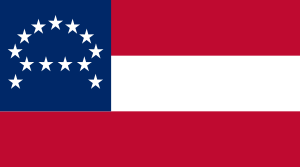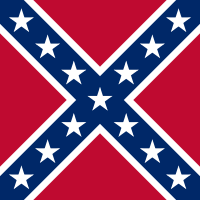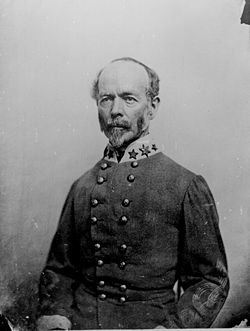Army of Northern Virginia
| Army of Northern Virginia | |
|---|---|
 Flag of the Army of Northern Virginia during Lee's command |
|
| Active | 1861-1865 |
| Country | Confederate States of America |
| Branch | Confederate States Army |
| Role | Premier Confederate Army in Eastern Theater |
| Garrison/HQ | Richmond, Virginia |
| Engagements | American Civil War |
| Commanders | |
| Notable commanders |
P.G.T. Beauregard Joseph E. Johnston Gustavus Woodson Smith Robert E. Lee |
The Army of Northern Virginia was the primary military force of the Confederate States of America in the Eastern Theater of the American Civil War. It was most often arrayed against the Union Army of the Potomac. Three districts were created under the Department of Northern Virginia:
- Aquia District
- First commander: Maj. Gen. Theophilus H. Holmes
- Period of existence: October 22, 1861, to April 18, 1862
- Potomac District
- First commander: Gen. P. G. T. Beauregard
- Period of existence: October 22, 1861, to January 29, 1862
- Valley District
- First commander: Maj. Gen. Thomas J. "Stonewall" Jackson
- Period of existence: October 22, 1861, to April 9, 1865
While the Aquia and Potomac Districts ceased to exist by the spring of 1862, the need remained for military organization in the Valley throughout the remainder of the war, and the Valley District remained in place for the duration of the war.
Contents |
Origin

The name Army of Northern Virginia referred to its primary area of operation, as did most Confederate States Army names. The Army originated as the (Confederate) Army of the Potomac, which was organized on June 20, 1861, from all operational forces in northern Virginia. On July 20 and July 21, the Army of the Shenandoah and forces from the District of Harpers Ferry were added. Units from the Army of the Northwest were merged into the Army of the Potomac between March 14 and May 17, 1862. The Army of the Potomac was renamed Army of Northern Virginia on March 14. The Army of the Peninsula was merged in April 12, 1862.[1]
Robert E. Lee's biographer, Douglas S. Freeman, asserts that the army received its final name from Lee when he issued orders assuming command on June 1, 1862.[2] However, Freeman does admit that Lee corresponded with Joseph E. Johnston, his predecessor in army command, prior to that date and referred to Johnston's command as the Army of Northern Virginia. Part of the confusion results from the fact that Johnston commanded the Department of Northern Virginia (as of October 22, 1861) and the name Army of Northern Virginia can be seen as an informal consequence of its parent department's name. Jefferson Davis and Johnston did not adopt the name, but it is clear that the organization of units as of March 14 was the same organization that Lee received on June 1, and thus it is generally referred to today as the Army of Northern Virginia, even if that is correct only in retrospect.
In addition to Virginians, it included regiments from all over the Confederacy, even those as far away as Texas and Arkansas. Of those, one of the most well known was the Texas Brigade, made up of the 1st, 4th, and 5th Texas, and the 3rd Arkansas, which distinguished themselves in numerous battles, perhaps most notably during their fight for the Devil's Den at the Battle of Gettysburg. Militiamen from the New Mexico and Arizona territories also served among its members.
Command under Brigadier General P. G. T. Beauregard

The first commander of the Army of Northern Virginia was General P.G.T. Beauregard (under its previous name, Army of the Potomac) from June 20 to July 20, 1861. His forces consisted of six brigades, with various militia and artillery from the former Department of Alexandria. During his command, Gen. Beauregard is noted for creating the battle flag of the army, which came to be the primary battle flag for all corps and forces under the Army of Northern Virginia. The flag was designed due to confusion during battle between the Confederate "Stars and Bars" flag and the flag of the United States. Beauregard continued commanding these troops as the new First Corps under Gen. J. E. Johnston as it was joined by the Army of the Shenandoah on July 20, 1861, when command was relinquished to General J. E. Johnston. The following day this army fought its first major engagement in the First Battle of Manassas.
Command under General J. E. Johnston

With the merging of the Army of the Shenandoah, Gen. Joseph E. Johnston took command from July 20, 1861, until May 31, 1862.
Corps organization under Johnston
- First Corps - commanded by Brig. Gen. P. G. T. Beauregard
- Second Corps - commanded by Maj. Gen. G. W. Smith
Under the command of Johnston, the Army immediately entered into the First Battle of Manassas. On October 22, 1861, the Department of Northern Virginia was officially created, officially ending the Army of the Potomac. The Department comprised three districts: Aquia District, Potomac District, and the Valley District. In April 1862 the Department was expanded to include the Departments of Norfolk and the Peninsula (of Virginia). Gen. Johnston was eventually forced into maneuvering the Army southward to the defenses of Richmond during the opening of the Peninsula Campaign, where it conducted delay and defend tactics until Johnston was severely wounded at the Battle of Seven Pines.
Temporary command under Major General G. W. Smith
The army was very briefly commanded by Maj. Gen. Gustavus Woodson Smith on May 31, 1862, following the wounding of Gen. J. E. Johnston, while President Jefferson Davis drafted orders to place Gen. Robert E. Lee in command the following day.
Command under General R. E. Lee



On June 1, 1862, its most famous, and final, leader, General Robert E. Lee, took command after Johnston was wounded, and Smith suffered what may have been a nervous breakdown, at the Battle of Seven Pines. In the first year of his command, Lee had two principal subordinate commanders. The "right wing" of the army was under the command of Lt. Gen. James Longstreet and the left wing under Lt. Gen. Thomas J. "Stonewall" Jackson. These wings were redesignated as the First Corps (Longstreet) and Second Corps (Jackson) on November 6, 1862. Following Jackson's death after the Battle of Chancellorsville, Lee reorganized the army into three corps on May 30, 1863, under Longstreet, Lt. Gen. Richard S. Ewell, and Lt. Gen. A.P. Hill. A Fourth Corps, under Lt. Gen. Richard H. Anderson, was organized on October 19, 1864; on April 8, 1865, it was merged into the Second Corps. The commanders of the first three corps changed frequently in 1864 and 1865. The Cavalry Corps was led by Maj. Gen. J.E.B. Stuart. It was established on August 17, 1862, and abolished on May 11, 1864 (the day Stuart was mortally wounded), with cavalry units being assigned to the headquarters of the Army. The Reserve Artillery was commanded by Brig. Gen. William N. Pendleton.[1]
Corps organization under Lee
Although the Army of Northern Virginia swelled and shrank over time, its units of organization consisted primarily of the following corps, sometimes referred to as "wings" or "commands":
- First Corps
- Second Corps
- Third Corps
- Fourth Corps, often styled Anderson's Corps
- Cavalry Corps
Campaigns and battles
The Army fought in a number of campaigns and battles, including:
| Campaign | Year | Army strength at the beginning of campaign | Major Battles |
|---|---|---|---|
| Peninsula Campaign | 1862 | 55,633 | Seven Pines (Fair Oaks) |
| Seven Days Battles | 1862 | aprox. 92,000 | Gaines' Mill, Malvern Hill |
| Northern Virginia Campaign | 1862 | aprox. 54,000 | Second Bull Run (Second Manassas) |
| Maryland Campaign | 1862 | aprox. 60,000 | Antietam (Sharpsburg) |
| Fredericksburg Campaign | 1862 | aprox. 75,000 | Fredericksburg |
| Chancellorsville Campaign | 1863 | aprox. 75,000 | Chancellorsville |
| Gettysburg Campaign | 1863 | 75,054 | Gettysburg |
| Bristoe Campaign | 1863 | 55,221 | |
| Mine Run Campaign | 1863 | ||
| Overland Campaign | 1864 | 62,230 | Wilderness, Spotsylvania Court House, Cold Harbor |
| Richmond-Petersburg Campaign | 1864–65 | 82,633 | Siege of Petersburg, including the Battle of the Crater |
| Appomattox Campaign | 1865 | around 50,000 | Five Forks |
On April 9, 1865, the Army of Northern Virginia surrendered to the Army of the Potomac at Appomattox Court House, effectively ending the Civil War, with General Lee signing the papers of surrender to General Ulysses S. Grant. The day after his surrender, Lee issued his Farewell Address to the Army of Northern Virginia.
Characteristics
The army was noted for its aggressiveness and audacity[3], almost always pitted in battle against an opponent superior in numbers[4], sometimes (such as at Sharpsburg and Chancellorsville) more than two-to-one.
See also
- Gettysburg Confederate order of battle (detailed command organization at the Battle of Gettysburg, 1863)
- Virginia Units in the Civil War
References
- Eicher, John H., and Eicher, David J., Civil War High Commands, Stanford University Press, 2001, ISBN 0-8047-3641-3.
- Freeman, Douglas S., R. E. Lee, A Biography (4 volumes), Scribners, 1934.
Notes
|
|||||||
|
|||||